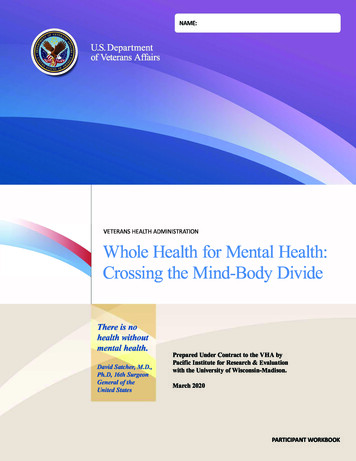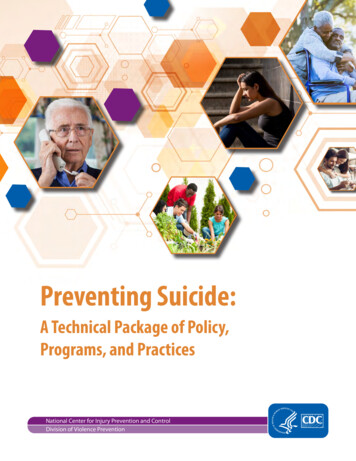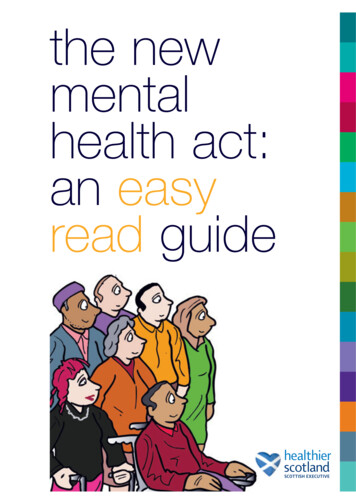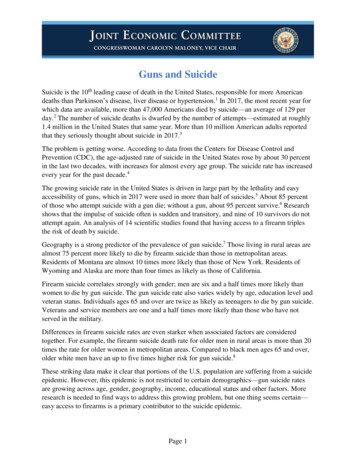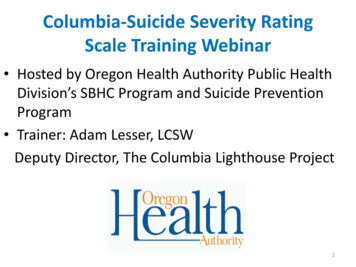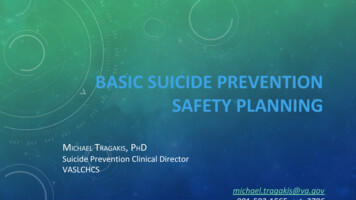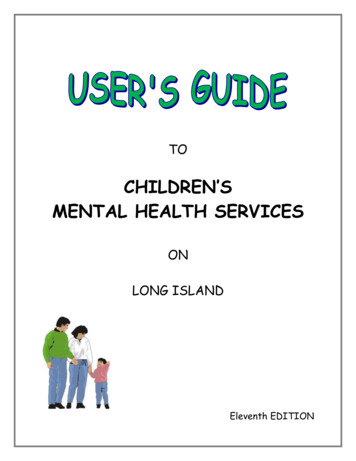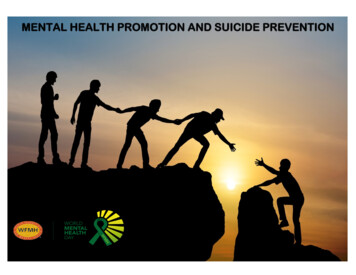
Transcription
MENTAL HEALTH PROMOTION AND SUICIDE PREVENTION
TABLE OF CONTENTSPageMessage from the WFMH President, Alberto Trimboli 3Mental Illness and Suicide Prevention, Gabriel Ivbijaro, Lucja Kolkiewicz, Sir David Goldberg KBE, Michelle Riba, Isatou N’jie, Jeffrey Geller 4The Warning Signs of Suicide, Befrienders .10Suicide and Older Adults, Carlos A de Monedoca Lima, D. De Leo, U. Arnautovska, et al. .12The Role of the Media in Promoting and Preventing Suicide, International Association for Suicide Prevention .19Opening Minds, Opening Doors—Media Guidelines, World Federation for Mental Health .21Recommendations for Reporting on Suicide , In Collaboration with Several International Organizations 23The Impact of Suicide, Susan Weinstein . . . . . . .25Beyond the Why, Natasha Müller . . . . . . . .27A Caring Conversation: What Suicide Prevention Can Look Like, Robert Olson/Centre for Suicide Prevention. . . . . . 29National Suicide Prevention Strategies: Progress and Challenges at Global Level, Ella Arensman, Murad Khan . . . 33Preventing Suicide: A Community Engagement Toolkit, World Health Organization and Mental Health Commission of Canada .35World of Thanks . . . . . . . . . . . . . . . . . . . . . . . . . . . . . . . . . . . . .39Page 2 of 40
MESSAGE FROM THE PRESIDENTDear Friends:This year, the World Federation for Mental Health (WFMH) has decided to make “suicide prevention” the main theme of World Mental Health Day.While suicidal behavior has existed throughout human history, it has increased gradually in all parts of the world and, in the past few decades, has reached alarmingstatistical levels.While the World Health Organization (WHO) has made suicide a priority issue for a number of years, it is important to emphasize that it is a topic that has attractedthe interest of most fields of study for centuries; thus, it has been explored by philosophy, religion, medicine, sociology, bioethics, law, and psychology, among otherfields.According to the WHO, more than 800,000 people die by suicide a year, making it the principal cause of death among people fifteen to twenty-nine years old. It isoften believed that it is only adults who exhibit suicidal behaviors, but it should be stressed that many children and young people also engage in this kind of behavioras a result of violence, sexual abuse, bullying and cyberbullying.Suicide is a global public health problem that deserves the attention of all the actors in the field of mental health, including scientific and professional organizations,organizations for mental health users and their families, and universities. It is particularly important to have the attention of national health authorities since it is theirresponsibility to craft policies and directives aimed at establishing strategies to prevent suicide and promote the public’s mental health. The role of both print andaudiovisual communication media and of social media is no less important, since their participation can have positive as well as negative effects, depending on howthey address this subject.There are numerous complex factors that contribute to a suicide, but it is most important is that our actions be geared toward prevention.Suicide is confusing, painful and mysterious, but it is preventable. The WFMH is concerned about the increase in numbers of suicides while resources, education,crisis lines and action plans for prevention aren’t keeping up. This is the reason we chose to focus our 2019 campaign on this topic.We hope this material will give you information to educate yourself and your community. We hope the information will inspire you to do more to help others, torecognize the signs and hopefully save more lives. We must keep the fight going, together, to bring people back from the darkness and into the light!Join us this year as we focus on suicide prevention. We are partnering and collaborating with many groups around the world to make this an amazing year of positivechange. We hope you will support our efforts and keep the spotlight on suicide prevention!Thank you for your ongoing support of World Mental Health Day!Alberto TrimboliWFMH Board PresidentPage 3 of 40
MENTAL ILLNESS AND SUICIDE PREVENTIONGabriel Ivbijaro, Lucja Kolkiewicz, Sir David Goldberg KBE, Michelle Riba, Isatou N’jie, Jeffrey GellerWorld Mental Health Day 2019 focuses on the major public concern of mental health promotion and suicide prevention.According to the World Health Organization, over 800,000 people die by suicide every year. While suicide is considered a serious problem in highincome countries and the tenth leading cause of death in the US (American Foundation for Suicide Prevention 2017), it is also the fifth leading cause ofdeath in China and 79% of suicide occurs in low and medium income countries (WHO 2018).Suicide rates vary between and within nations. The UK suicide rate is 10.1 suicides per 100,000 population with the highest rate in Scotland (13.9suicides per 100,000 population) and the lowest in England (9.2 deaths per 100,000 population) (Office for National Statistics 2017).The highest rates of suicide worldwide are currently Lithuania (31.9 suicides per 100 000 population), Russia (31 per 100 000 population), Guyana(29.2 per 100 000 population), South Korea (26.9 per 100 000 population) and Belarus (26.2 per 100 000 population). The lowest rates are reported inthe Caribbean in Barbados (0.8 suicides per 100 000 population) and Barbuda (0.5 suicides per 100 000 population) (World Population Review 2019).In contrast with many other countries, most of the people who die of suicide in China are women—most likely because of strain and stress, poverty andstigma associated with mental illness. In Japan, it’s the leading cause of death among men aged 20-44 and women aged 15-34, which has reachedcrisis level with the Government intervening to decrease the risk among vulnerable populations (World Population Review 2019).A key objective of the 2019 World Mental Health Day campaign is to reduce the rate of suicide throughout the world.To achieve this goal, the following goals are essential: prevention of mental illness, promotion of good health, reduction in the stigma associated withmental illness and improved access to evidence based mental health care.The story described below illustrates some of the issues and suffering that can occur when people are in distress and believe that suicide is the onlyway out.Sarah was a petite 22- year old who moved from a small town to a midsize city where she got a factory job. She knew no one in her new locale andkept to herself as she always had done. She dreaded others would learn she had grown up in poverty raised by her grandparents. She becamedepressed and self-medicated with alcohol. Her drinking impaired her work performance and she was fired. Unable to pay her rent, she was relegatedto living on the streets. One night she went into a bar, ordered a drink, and told the bartender she’d be right back. Sarah never returned to the bar. Shewas found dead, hanging from a bathroom stall door with her bra around her neck. There was a note pinned to her blouse: “Tell my Grandma I’msorry.”This requires each of us to play our part.Page 4 of 40
Suicide and Mental Illness—What Do We Know?Somebody somewhere in the world dies of suicide every forty seconds. Ninety percent of these individuals have a clinically diagnosable mental illness(Hawton et al. 2001). Depression and alcohol addiction are major risk factors (Nock 2009). One third of suicides occur in young people and is theleading cause of death in those aged between 15 years and 29 years old, and the second most common cause of death in women between 15 and 19years old.Screening and identification of suicide risk in healthcare settings is important because many people present to healthcare settings in the months priorto completed suicide (King CA et al. 2017) and current evidence suggests that many suicides due to a diagnosable mental disorder are preventable(Strathdee et al. 2012). Screening for suicide in healthcare settings is possible and can identify those at increased risk so that appropriate actions canbe taken (Boudreux et al. 2016; King et al. 2009).The incidence of suicide in adolescents is rising despite the implementation of suicide prevention programmes targeting young people who areparticularly vulnerable; suicide continues to be the leading cause of death in adolescents. This age group has difficulty navigating access to care andmaking a disclosure, especially when they are experiencing psychological stress or symptoms of mental illness (Cauce et al. 2002; Srebnik et al. 1996;Klimes-Dougan et al. 2013; Chen et al. 2012).Adolescents at increased risk of suicide have increased suicidal ideation, anxiety, agitation and sleep disturbance, difficulty with adapting to newsituations, associated alcohol and drug use, peer victimization and increased prevalence of sexual and physical trauma (King et al. in press). Thishighlights the need for collaboration among policy makers, schools, housing and healthcare providers to develop a holistic approach to identify andrespond to suicidal ideation in the adolescent population. Education about the safe use of social media and protection of the young from cyberbullyingand exposure to inappropriate and inaccurate advice is of increasing importance.Older adults are also vulnerable to suicide and the proportion of older adults in the general population is increasing (de Mendoça Lima & Ivbijaro 2019).Older adults often experience comorbid mental and physical disorder including dementia.A 2011 expert consensus panel noted that not enough was being done to address suicidality in older adults and recommended that special effortsneed to be in place to identify mental illness and frailty in older adults earlier, including suicide risk, so that management plans addressing suicidalideation can be implemented (Erlangsen et al. 2011; Rockwood K 2005).Universal actions suggested to better identify mental illness in older adults include administration of self-administered depression screening tools,tackling disability and social isolation including family, friends and carers as much as possible whilst respecting their wishes, and recognising thespecific role of family practitioners and social services staff.Suicide and Contact with the Family Doctor/General PractitionerAccording to Goldberg & Huxley (1992), the majority of people with a diagnosable mental disorder presenting to their General Practitioner (GP) do nothave their mental illness identified. In the restricted time available, doctors understandably give high priority to the exclusion of physical causes for thepatient’s symptoms. Most episodes of what turns out to be psychological distress will present with somatic symptoms, and the possibility of anemotional disorder may be delayed until a later stage.Page 5 of 40
More than 40 global studies show that 75% of patients who complete suicide have contact with their GPs in the previous 12 months (Luoma et al.2002). Over 81% of the UK adult working population have contact with their GPs within any 12 month period, and evidence suggests that suicideprevention training for GPs working in this type of system is effective at reducing the risk of future suicide by 50%, particularly in those people with adiagnosis of depression because they are then referred for psychological therapies such as Cognitive Behaviour Therapy (CBT) (Bermingham S et al.2010).Suicide prevention strategies aimed at general practice can be effective and can lead to healing for the individual and family concerned and haveeconomic benefits for the state (McDaid et al. 2011).Suicide and Mental Health In-Patient AdmissionMany people, who require hospital admission for the treatment of mental illness, as well as their relatives, believe that hospital is a safe place thatpromotes healing. This is not always the case.Sometimes people who are mental health in-patients harm themselves and the first few weeks after discharge from an in-patient mental health unit arealso a period of high risk for suicide.An English national survey of people who completed suicide between 1996 and 2000 (Meehan et al. 2006) showed that 16% of those people who hadbeen in contact with mental health services died whilst they were in-patients in a mental health unit, approximately 20% died within seven days ofadmission and 23% died within three months of discharge.People who are mental health in-patients and who die as a result of suicide have a variety of diagnoses. One third have a diagnosis of schizophrenia,one third a diagnosis of depressive disorder and the remainder have a variety of diagnoses including bipolar affective disorder, personality disorder,anxiety disorder, alcohol dependence and drug dependence.Preventing Suicide in In-Patient UnitsLevel of observation and staffing are very important in the prevention of suicide on in-patient wards, and there is a correlation between level ofobservation and completed suicide.Seventy-two percent of those who die as a result of suicide on in-patient mental health wards are being nursed on low level observations and are beingchecked every 30 minutes or longer. Twenty-three percent of people who complete suicide on an in-patient mental health ward are on medium levelobservations and are being checked every 5 to 25 minutes and 3% of people on high level one to one observations complete suicide (Meehan 2006).Medical staff believe that over 30% of in-patient suicides are preventable by taking the following measures: Good observationsAdherence to treatment to more effectively treat symptoms of mental illnessHigher staffing levelsBetter staff trainingPage 6 of 40
Future Developments in Mental Illness and Suicide PreventionResearch into suicide and the prevention of suicide does not get the attention it deserves, partly because it is associated with many differentpsychiatric diagnoses and, in some countries, it is considered a crime.Funding for suicide prevention is disproportionately low when compared to prevention of other problems that affect a high proportion of the youngerpopulation such as road traffic accidents.Between 2002–2006 and 2013–2017, the Scottish suicide rate fell by 20%. Over much of the last 30 years the suicide rate in Scotland has beenconsistently lower than the average across the 53 countries of the WHO European Region. Key ingredients of success include restricting access tomeans (pesticides, firearms); influencing the media to modify the way in which mental disorders are covered; enhancing young people’s problemsolving, coping and life skills; and early identification, assessment and follow up so that people at risk of suicide. Of course, it is not known which, ifany, of these measures was effective in bringing down the suicide rate.The WHO produced three key publications that help us to understand how to prevent suicide. The first of these three publications drew attention to anumber of possible factors that might be responsible for lowering the suicide rate, and these included medical interventions such as treatment withlithium or neuroleptics, as well as interventions in the community, such as school based preventive programs, multifaceted suicide preventionprogrammes and restricting access to lethal methods such as firearms and toxic chemicals (WHO 2012).The second key publication clarified the model used, as well as emphasising the fact that suicide in LAMI countries has a peak for young adults, incontrast to the greater age in high income countries (WHO 2014).The third key publication introduces a five point plan for interventions: first, to restrict access to methods of suicide; secondly, to interact with the newsmedia to modify the way in which mental disorders are presented to the public; third, to influence young people’s problem solving skills, coping and lifeskills; fourth, early identification of those who are at high risk of suicide, such as patients discharged from psychiatric care. This paper draws attentionto the need for staff training and a budget to support continuing activities (WHO 2018).As a result of these papers many countries have produced national policies for the prevention of suicide and detailed description of their successshould be available over the next few years and we would recommend that people review their approach to suicide prevention when the results areavailable.There is a problem in that training possible gatekeepers to mental health care may not persist after initial enthusiasm has died down. Gatekeepertraining has been implemented and studied in many populations, including military personnel; public school staff, peer helpers, clinicians, andAboriginal people (Isaac et al. 2009).This type of training has been shown to positively affect the knowledge, skills, and attitudes of trainees regarding suicide prevention. Large-scalecohort studies in military personnel and physicians have reported promising results with a significant reduction in suicidal ideation, suicide attempts,and deaths by suicide. Extensive follow up reduced the risk of suicide (Inagki et al. 2005).The prevention training developed by WHO is called ‘brief intervention and contact’ (BIC) and consists of a one-hour interview as soon as possibleafter the person was discharged from hospital, followed by regular checks over the next 18 months. Riblet and her colleagues (2017) have succeededPage 7 of 40
in identifying 8,647 citations, including 72 RCTs and 6 pooled analyses about the prevention of suicide and concluded that the World HealthOrganization’s ‘brief intervention and contact’ works (Fleishman et al. 2008).Recommendations To improve mental health literacy in the community so that people can identify mental distress and mental illness earlier ensuring people get moreeffective help. To improve the skills of community and primary care health professionals in the recognition of signs of mental illness and suicidality at first contact. To ensure that general hospital and secondary mental health care staff have enough training and manpower to identify those people at increasedrisk of suicide so that an appropriate prevention plan can be put in place, particularly during the first two weeks of admission and the first twoweeks following discharge when suicide risk is at its highest. Governments to increase their funding into suicide research and public health measures to improve prevention. Policy makers, WHO and international professional colleges to work collaboratively to develop better tools for rating suicide risk and for developingeffective management plans for suicide prevention. Psychological first aid to be included in all first aid training courses in order to raise awareness of mental health problems and provide the generalpublic with increased confidence and skills to identify mental health crisis and problems and obtain early help. Collaborative working between those involved in developing and influencing mental health classification systems in order to consider suicide moreexplicitly in mental health diagnosis to enabling early identification of those at increased risk and the development of treatment plans to supportpreventive action. Regulators to include suicide prevention indicators and suicide rates as part of mental health key performance indicators. Develop a global agenda and consensus on tackling mental health stigma in suicide prevention strategies. Brief intervention and contact (BIC) works.REFERENCESAmerican Foundation for Suicide Prevention. 2017. Suicide Statistics. [Online]. [26 June 2019]. Available from: World Health Organisation. 2018. Suicide: key facts. [Online]. [26 June 2019]. Available from: l/suicideOffice for National Statistics. 2017. Suicides in the UK: 2017 registrations. [Online]. [26 June 2019]. Available uicidesintheunitedkingdom/2017registrationsWorld population review. 2019. Suicide Rate by Country, 2019. [Online]. [26 June 2019]. Available from: -rate-by-country/Hawton K, van Heeringen K: Suicide. Lancet 2009; 373:1372–1381Nock MK et al. PLOS Med 6 e1000 123 (2009)King CA, Horowitz A, Czyz E, Lindsay R. Suicide risk screening in healthcare settings: identifying males and females at risk. Journal of Clinical Psychology in Medical Settings. 2017; 24(1): 8-20.Doi:10.1007/s10880-017-9486-yStrathdee G, Ghosh P, Gunn S, Ivbijaro G, Kolkiewicz L. Risk assessment and the management of suicidality in primary care mental health pp178–202. In. Companion to Primary Care Mental Health EditorIvbijaro G: Radcliffe. 2012Boudreaux ED, Camargo CA, Arias SA, Sullivan AF, Allen MH, Goldstein AB, Miller IW. Improving suicide risk screening and detection in the emergency department. American Journal of Preventive Medicine.2016; 50(4): 445-453. DOI: 10.1016/j.amepre.2015.09.029King CA, O’Mara RM, Hayward CN, Cunningham RM. Adolescent suicide risk screening in the emergency department. Academic Emergency Medicine. 2009; 16(11): 1234-1241. Doi: 10.1111/j.15532712.2009.00500Cauce AM, Domenech-Rodriguez M, Paradise M, Cochran B, Srebnik D, Baydar N. Cultural and contextual issues in mental health help seeking: a focus on ethnic minority youths. Journal of Consulting andClinical Psychology. 2002: 70(1); 44-55Srebnik D, Cauce AM, Baydar N. Help-seeking pathways for children and adolescents. Journal of Emotional and Behavioural Disorders. 1996: 4; 210-220Klimes-Dougan B, Klingbeil DA, Meller SJ. The impact of universal suicide-prevention programs on the help-seeking attitudes and behaviors of youths. Crisis. 2013: 34(2); 82-97Chen VC-H, Huang S-H, Lee M-C. Adolescent mental health in primary care. pp 553–570. In. Companion to Primary Care Mental Health Editor Ivbijaro G: Radcliffe. 2012de Mendonça Lima CA, Ivbijaro G (eds) Primary Care Mental Health in Older People, Springer, Cham. 2019Page 8 of 40
King CA, Grupp-Phelan J, Brent D, Dean JM, Webb M, Bridge JA, Spirito A, Chernick L, Mahabee-Gittens EM, Mistry RK, Rea M, Keller A, Rogers A, Shenoi R, Cwik M, Busby D, Casper TC and the PediatricEmergency Care Applied Research Network. Predicting 3-month risk for adolescent suicide attempts among pediatric emergency department patients. Journal of Child Psychology and Psychiatry inpressErlangsen A, Nordentoft M, Conwell Y, Waern M, De Leo D, Lindner R, Oyama H, Sakashita T, Andersen-Ranberg K, Quinnett P, Draper B, Lapierre S & International Research Group on Suicide Among theElderly. Key considerations for preventing suicide in older adults. Consensus opinions of an expert panel. Crisis. 2011: 3(2); 106-109Rockwood K. What would make a definition of frailty successful? Age and Ageing. 2005: 34; 432-434Goldberg & Huxley .Common Mental Disorders: A Bio-social Model. London: Tavistock/Routledge: London: Tavistock/Routledge 1992Luoma JB, Martin CE, Pearson JL. Contact with mental health and primary care providers before suicide: a review of the evidence. American Journal of Psychiatry. 2002: 159; 909-916Bermingham S, Cohen A, Hague J, Parsonage M. The cost of somatisation among the working-age population in England for the year 2008/09. Mental Health in Family Medicine. 2010: 7(2): 71-84McDaid D, Park A-L, Bonin E-M. Population level suicide awareness training and intervention pp 26-28. In: Mental health promotion and mental illness prevention: the economic case Editors Knapp M, McDaidD, Parsonage M: Department of Health, London. 2011Meehan J, Kapur N, Hunt IM, Turnbull P, Robinson J, Bickley H, Parsons R, Flynn S, Burns J, Amos T, Shaw J & Appleby L. Suicide in mental health in-patients and within 3 months of discharge. BritishJournal of Psychiatry. 2006; 188; 129-134WHO. For Which strategies of suicide prevention is there evidence of effectiveness? Geneva: World Health Organization 2012. ISSN 2227-4316WHO. Preventing suicide—a global imperative. Geneva: World Health Organization 2014. ISBN 978 92 4 156477 9WHO. National suicide prevention strategies. Progress, examples and indicators. Geneva: World Health Organization; 2018Isaac M., Elias R, Katz YK et al. Gatekeeper Training as a Preventative Intervention for Suicide: A Systematic Review. Canadian Journal of Psychiatry. 2009; 54(4):260–268.Inagaki M, Kawashima Y, Kawanishi C, Yonemoto N, Sugimoto T, Furuno T, et al. Interventions to prevent repeat suicidal behavior in patients admitted to an emergency department for a suicide attempt: ameta-analysis. Journal of Affective Disorders 2015; 175: 66–78Riblet NBV, Shiner B, Young-Xu Y et al. Strategies to prevent death by suicide: meta-analysis of randomised controlled trials. The British Journal of Psychiatry (2017) 210, 396–402. doi: 10.1192Fleischmann A, Bertolote JM , Wasserman D et al. Effectiveness of brief intervention and contact for suicide attempters: a randomized controlled trial in five countries WHO Bulletin 2008, 86 (9), 657–736.Gabriel IvbijaroPast President WFMH; Visiting Professor, NOVA University, Lisbon, Portugal; Visiting Fellow Faculty of Management, Law & Social Sciences, University of Bradford, UK; President, The World Dignity ProjectCorresponding author e-mail: gabriel.ivbijaro@gmail.comLucja KolkiewiczVisiting Professor, NOVA University, Lisbon, Portugal; Consultant Psychiatrist East London NHS Foundation Trust, London, UKE-mail: lucja.kolkiewicz@nhs.netSir David Goldberg KBEEmeritus Professor Kings College, London, UKE-mail: davidpgoldberg98@gmail.comMichelle RibaClinical Professor, Department of Psychiatry, University of Michigan, USAPast President, American Psychiatric AssociationE-mail: mriba@umich.eduIsatou N’jieAssistant Librarian Systems, MCLIP Knowledge and Library Services Barts Health NHS Trust Whipps Cross University Hospital, London, UKE-mail: isatou.njie@nhs.netJeffrey GellerDirector WFMH; President Elect APA; Professor of Psychiatry, University of Massachusetts Medical SchoolE-mail: Jeffrey.Geller@umassmed.eduAcknowledgementsThanks to our peer reviewers particularly, Cheryl A King, at the University of Michigan for her helpful feedback.Page 9 of 40
THE WARNING SIGNS OF SUICIDEBefriendersSuicide is rarely a spur of the moment decision. In the days and hours before people kill themselves, there are usually clues and warning signs.The strongest and most disturbing signs are verbal—"I can't go on," "Nothing matters any more" or even "I'm thinking of ending it all." Such remarksshould always be taken seriously.Other common warning signs include: Becoming depressed or withdrawnBehaving recklesslyGetting affairs in order and giving away valued possessionsShowing a marked change in behavior, attitudes or appearanceAbusing drugs or alcoholSuffering a major loss or life changeThe following list gives more examples, all of which can be signs that somebody is contemplating suicide. Of course, in most cases these situations donot lead to suicide. But, generally, the more signs a person displays, the higher the risk of suicide.Situations Family history of suicide or violenceSexual or physical abuseDeath of a close friend or family memberDivorce or separation, ending a relationshipFailing academic performance, impending exams, exam resultsJob loss, problems at workImpending legal actionRecent imprisonment or upcoming releaseBehaviors CryingFightingBreaking the lawImpulsivenessSelf-mutilationPage 10 of 40
Writing about death and suicidePrevious suicidal behaviorExtremes of behaviorChanges in behaviorPhysical Changes Lack of energyDisturbed sleep patterns—sleeping too much or too littleLoss of appetiteSudden weight gain or lossIncrease in minor illnessesChange of sexual interestSudden change in appearanceLack of interest in appearanceThoughts and Emotions Thoughts of suicideLoneliness—lack of support from family and friendsRejection, feeling marginalizedDeep sadness or guiltUnable to see beyond a narrow focusDaydreamingAnxiety and stressHelplessnessLoss of self-worthThis factsheet is available in 16 different languages on the Befrienders Worldwide website: www.befrienders.orgPage 11 of 40
SUICIDE AND OLDER ADULTSC.A. de Monedoca Lima, D. De Leo and U. ArnautovskaThis article is adapted from the chapter titled “Suicidal Behaviour in Older Adults,” by D. De Leo and U. Arnautovska, in the book Primary Care MentalHealth in Older People: A Global Perspective, edited by Carlos Augusta de Mendonça Lima and Gabriel Ivbijaro. Springer, 2019.According to the World Health Organization (WHO), “suicide is the result of an act deliberately initiated and performed by a person in the fullknowledge or expectation of its fatal outcome.”1 It is a major public mental health problem. Suicide is a human phenomenon found in all cultures, inboth sexes, in all ages and throughout history. It has different meanings according to the context of the person’s life, but the common feature in allcases of suicide is the presence of a suffering behind the decision to choose death over the uncertainty of a future perceived as unbearable.Commonly considered as “survivors of their own generation,” older adults may commit suicide for different reasons than younger adults. Thesedifferences are important to be identified because they may help to develop specific strategies to prevent suicide later in life.Although declining in many parts of the world for the past thirty years2, suicide rates among individuals aged 65 years and older are still the highest forboth men and women in almost all regions of the world3. In addition, increase
ideation can be implemented (Erlangsen et al. 2011; Rockwood K 2005). . In the restricted time available, doctors understandably give high priority to the excl usion of physical causes for the patient's symptoms. . diagnosis of depression because they are then referred for psychological therapies such as Cognitive ehaviour Therapy (CB BT .


